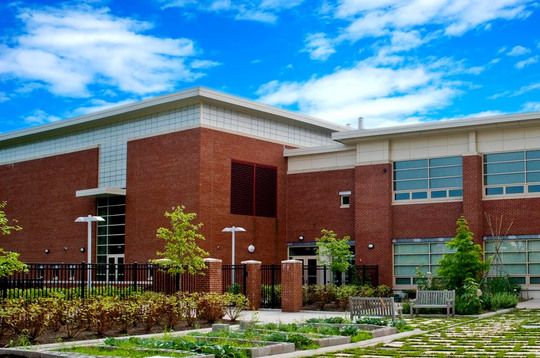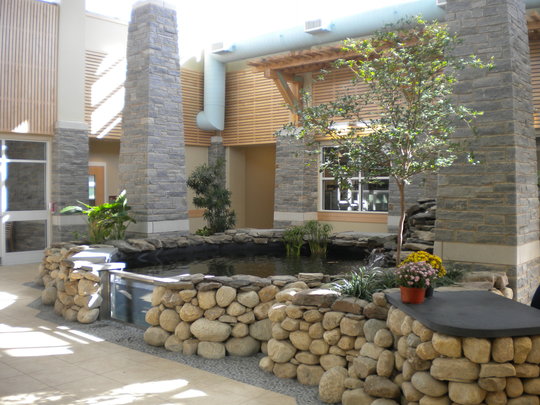ED Will Visit
Schools in Three States on New England Leg of ‘Education Built to Last’
Facilities Best Practices Tour
Special Advisor to the
Secretary Donald Yu and U.S. Department of Education Green Ribbon Schools
Director Andrea Falken will visit U.S. Department of Education Green
Ribbon Schools in Rhode Island, Connecticut and Massachusetts with
Regional EPA Administrator Curt Spalding on Monday and Tuesday, July 29
and 30, to see and discuss the ways school facilities can enhance the
conditions for learning. Federal officials will be joined by
commissioners of education from these states, local superintendents, and
other local, state, and regional stakeholders as they visit several
award-honored schools in each state.
The visit will include
tours of school buildings and grounds, conversations with students and
teachers regarding environmental education, health and sustainability,
and discussions with key partners and energy management personnel.
In addition, all state and district facilities personnel from the region
are invited to attend the opening panel and listening session on July
29th in Providence, RI. The listening session will allow facilities
experts in the region to share best practices on school facilities and
provide input to ED.
The Agenda
Come join us on July 29th
and 30th for a conversation on school facilities!
Monday, July 29th
Rhode Island
8:30 a.m. to 9:00 a.m.
Registration at Providence Career and Technical Academy- 41
Fricker St., Providence, RI 02903
9:00 a.m. to 10:45 a.m.
Panel and Facilities Best Practices Listening Session with
Rhode Island Commissioner Deborah Gist, Rhode Island Department of
Education and Susan Lusi, Superintendent Providence Public Schools
District
10:45 a.m. to 11:30 a.m.
Tour Providence Career and Technical Academy- 41 Fricker St.,
Providence, RI 02903
11:45 a.m. to 12:45 p.m.
Tour Nathan Bishop Middle School- 101 Sessions St.,
Providence, RI 02906
Connecticut
2:45 p.m. to 3:45 p.m.
Tour Common Ground High School- 358 Springside
Ave., New Haven, CT 06515
4:00 p.m. to 5:00 p.m.
Tour Barnard Environmental Studies Magnet School- 170
Derby Ave., New Haven, CT 06511
Tuesday, July 30th
8:30 a.m. to 9:30 a.m.
Tour Environmental Sciences Magnet at Mary Hooker- 440
Broadview Terrace, Hartford, CT 06106
Massachusetts
1:00 p.m. to 2:00 p.m.
Tour Manchester-Essex Middle/High School with Mitchell D. Chester,
MA Commissioner of Elementary and Secondary Education- 36 Lincoln
St., Manchester by the Sea, MA 01944
3:00
p.m. to 4:00 p.m.
Tour Quincy High
School with Mark Sylvia, MA Commissioner of the Office of Energy
Resources- 100 Coddington St., Quincy, MA 02169
The School
Facilities:
As PCTA was built on a
renovated brownfield site, environmental impact and health have become a
part of the school’s curriculum. Through each of the school’s five
construction-based career and technical education programs, students
engage in outdoor experiential learning to complete skills on a job site,
focusing on green building technology. Energy data, usage and cost are
monitored through EPA ENERGY STAR Portfolio Manager and data from the
National Grid. Recent PCTA renovations included installation of energy
recovery HVAC units, state of the art PDC controls with user interface
and solar water heating, and waterless urinals. The water used for
heating and cooling is tested weekly and chemical treatment is provided
to balance pH levels and control germs to comply with Narragansett
Watershed requirements. The controls for the dual temperature system
operate pumps, chillers and boilers to optimize efficiency and eliminate
waste.



Originally constructed in
1929, and renovated in 2009 according to criteria established by the
Collaborative for High Performance Schools, the school is a tool for
learning at Nathan Bishop. Nathan Bishop has integrated its energy
management efforts into the science curriculum by installing kiosks on
campus for displaying live energy data and demonstrating consumption
trends in energy and water. Twenty-five percent of the school’s energy
use is derived from on-site renewable energy generation.


When you enter Barnard’s
lobby, you see a powerful environmental studies theme that runs
throughout the school: student artwork, brightening and inspiring,
decorates the corridors and illustrates the school’s four overarching
environmental themes: the studies of fresh water, energy, migration, and
the Long Island Sound estuary. The school’s courtyard garden,
greenhouses, and its nature center are spaces for the students to explore
the natural world as they take on the roles of gardener, naturalist, and
environmentalist. The school’s nature center is adjacent to the
West River and these wetlands provide an outdoor classroom for students
who go canoeing with the park rangers and actively investigate the
habitat of the West River. The school’s Yale University sponsored,
school-based health center educates students through age appropriate
workshops.


The school’s campus, a
20-acre demonstration farm at the base of a state park in a city, creates
a powerful learning laboratory. Students collect data on recycling
and waste reduction on a weekly basis, and a paid team of students
manages recycling and composting programs. A solar array on the
roof demonstrates alternative energy options and provides data for
classroom manipulation, and a recent full-school lighting retrofit has
cut energy use. The school has begun construction on a
demonstration high-performing building, featuring a solar array that will
provide approximately 70 percent of electricity, and a geothermal system
will meet all heating and cooling needs. Rainwater gardens, an
educational wetland, and other features will demonstrate low-impact
design. The school’s urban farm grew more 7,000 pounds of fresh,
sustainable, local produce last year. Students participate in more
than a dozen outdoor adventure trips every year, engaging 100 percent of
urban students in hiking, camping, and other outdoor experiences.


Environmental Sciences
Magnet School at Mary Hooker (ESM) serves students from pre-kindergarten
through the 8th grade in a new, $41,000,000 LEED Platinum facility, which
includes a planetarium, butterfly vivarium, greenhouse, aquatics lab, and
organic community garden. The school shares its exceptional
facility with the community through a joint-use agreement. ESM
practices organic methods of gardening, Integrated Pest Management (IPM),
and composting; these methods are incorporated into the curriculum at all
grade levels and into parent-staff garden workshops. Students
participate in Discovery Camp programs, where they participate in
programs focused on team building and outdoor education.



Manchester Essex Regional
Middle High School, a Collaborative for High Performance Schools building,
constructed with recycled materials and energy-efficient design
principles, is home to a 650 gallon rainwater collection tank and over
100 donated plants and trees. The school achieved a 90 percent
reduction in waste through the installation of a state of the art
Lucidomatic waste sorting system and the implementation of a printing
limits program through PaperCut software. Manchester Essex, which
has reduced its heating per square foot by nearly 58 percent over three
years, meets 5 percent of its energy needs through on-site solar
panels. The edible schoolyard is a community-building and
educational tool that offers students and parents the opportunity to work
with the garden during the summer to raise awareness about local food and
organic gardening.

At Quincy High School, a
career and technical school, the building’s design allows for
collaboration among AP biology and environmental science students and
their peers who are pursuing Nursing or Applied Medical Technology
specialties. Quincy collaborated with the city’s planning department
to participate in the USGBC Center for Green Schools Green Apple Day of
Service, which provided real-world instruction about the importance of
energy reduction and implemented a National Wildlife Federation Cool
Schools Energy Audit. The school’s STEM wing is home to a
greenhouse, where students are actively involved in learning how to grow
their own food. Culinary students are responsible for front- and
back-of-house service at the wildly popular President’s Café, where
student-grown herbs are used in recipes. The school was certified
by the Massachusetts Collaborative for High Performing Schools in 2009
and EPA ENERGY STAR in 2008. The school has continued its efforts
by retro-commissioning the building to ensure that it performs as
intended. (Pictured below)

|









